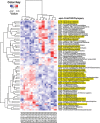Bacterial protein signals are associated with Crohn's disease
- PMID: 24436141
- PMCID: PMC4173658
- DOI: 10.1136/gutjnl-2012-303786
Bacterial protein signals are associated with Crohn's disease
Abstract
Objective: No Crohn's disease (CD) molecular maker has advanced to clinical use, and independent lines of evidence support a central role of the gut microbial community in CD. Here we explore the feasibility of extracting bacterial protein signals relevant to CD, by interrogating myriads of intestinal bacterial proteomes from a small number of patients and healthy controls.
Design: We first developed and validated a workflow-including extraction of microbial communities, two-dimensional difference gel electrophoresis (2D-DIGE), and LC-MS/MS-to discover protein signals from CD-associated gut microbial communities. Then we used selected reaction monitoring (SRM) to confirm a set of candidates. In parallel, we used 16S rRNA gene sequencing for an integrated analysis of gut ecosystem structure and functions.
Results: Our 2D-DIGE-based discovery approach revealed an imbalance of intestinal bacterial functions in CD. Many proteins, largely derived from Bacteroides species, were over-represented, while under-represented proteins were mostly from Firmicutes and some Prevotella members. Most overabundant proteins could be confirmed using SRM. They correspond to functions allowing opportunistic pathogens to colonise the mucus layers, breach the host barriers and invade the mucosae, which could still be aggravated by decreased host-derived pancreatic zymogen granule membrane protein GP2 in CD patients. Moreover, although the abundance of most protein groups reflected that of related bacterial populations, we found a specific independent regulation of bacteria-derived cell envelope proteins.
Conclusions: This study provides the first evidence that quantifiable bacterial protein signals are associated with CD, which can have a profound impact on future molecular diagnosis.
Keywords: Crohn's Disease; Enteric Bacterial Microflora; Inflammatory Bowel Disease.
Published by the BMJ Publishing Group Limited. For permission to use (where not already granted under a licence) please go to http://group.bmj.com/group/rights-licensing/permissions.
Figures






Comment in
-
Species-specific and pathotype-specific binding of bacteria to zymogen granule membrane glycoprotein 2 (GP2).Gut. 2015 Mar;64(3):517-9. doi: 10.1136/gutjnl-2014-307854. Epub 2014 Jul 29. Gut. 2015. PMID: 25073658 No abstract available.
Similar articles
-
Dysbiosis of fecal microbiota in Crohn's disease patients as revealed by a custom phylogenetic microarray.Inflamm Bowel Dis. 2010 Dec;16(12):2034-42. doi: 10.1002/ibd.21319. Inflamm Bowel Dis. 2010. PMID: 20848492
-
The bacteriology of biopsies differs between newly diagnosed, untreated, Crohn's disease and ulcerative colitis patients.J Med Microbiol. 2006 Aug;55(Pt 8):1141-1149. doi: 10.1099/jmm.0.46498-0. J Med Microbiol. 2006. PMID: 16849736
-
Modulation of faecal metagenome in Crohn's disease: Role of microRNAs as biomarkers.World J Gastroenterol. 2018 Dec 14;24(46):5223-5233. doi: 10.3748/wjg.v24.i46.5223. World J Gastroenterol. 2018. PMID: 30581271 Free PMC article.
-
[Intestinal flora and Crohn's disease].Ann Pharm Fr. 2003 Jul;61(4):276-81. Ann Pharm Fr. 2003. PMID: 12843962 Review. French.
-
Role of gut microbiota in Crohn's disease.Expert Rev Gastroenterol Hepatol. 2009 Oct;3(5):535-46. doi: 10.1586/egh.09.47. Expert Rev Gastroenterol Hepatol. 2009. PMID: 19817674 Review.
Cited by
-
Potential role of microbiome in Chronic Fatigue Syndrome/Myalgic Encephalomyelits (CFS/ME).Sci Rep. 2021 Mar 29;11(1):7043. doi: 10.1038/s41598-021-86425-6. Sci Rep. 2021. PMID: 33782445 Free PMC article.
-
Loss and Gain of Tolerance to Pancreatic Glycoprotein 2 in Celiac Disease.PLoS One. 2015 Jun 5;10(6):e0128104. doi: 10.1371/journal.pone.0128104. eCollection 2015. PLoS One. 2015. PMID: 26047356 Free PMC article.
-
Gut Microbiota Changes and Their Relationship with Inflammation in Patients with Acute and Chronic Insomnia.Nat Sci Sleep. 2020 Nov 5;12:895-905. doi: 10.2147/NSS.S271927. eCollection 2020. Nat Sci Sleep. 2020. PMID: 33177907 Free PMC article.
-
MDAKRLS: Predicting human microbe-disease association based on Kronecker regularized least squares and similarities.J Transl Med. 2021 Feb 12;19(1):66. doi: 10.1186/s12967-021-02732-6. J Transl Med. 2021. PMID: 33579301 Free PMC article.
-
Advances in multi-omics integrated analysis methods based on the gut microbiome and their applications.Front Microbiol. 2025 Jan 3;15:1509117. doi: 10.3389/fmicb.2024.1509117. eCollection 2024. Front Microbiol. 2025. PMID: 39831120 Free PMC article. Review.
References
-
- D'Haens GR, Geboes K, Peeters M, et al. Early lesions of recurrent Crohn's disease caused by infusion of intestinal contents in excluded ileum. Gastroenterology 1998;114:262–7 - PubMed
-
- Rutgeerts P, Hiele M, Geboes K, et al. Controlled trial of metronidazole treatment for prevention of crohn's recurrence after ileal resection. Gastroenterology 1995;108:1617–21 - PubMed
-
- Mathew CG. New links to the pathogenesis of Crohn disease provided by genome-wide association scans. Nat Rev Genet 2008;9:9–14 - PubMed
-
- Cho JH. The genetics and immunopathogenesis of inflammatory bowel disease. Nat Rev Immunol 2008;8:458–66 - PubMed
Publication types
MeSH terms
Substances
LinkOut - more resources
Full Text Sources
Other Literature Sources
Medical
